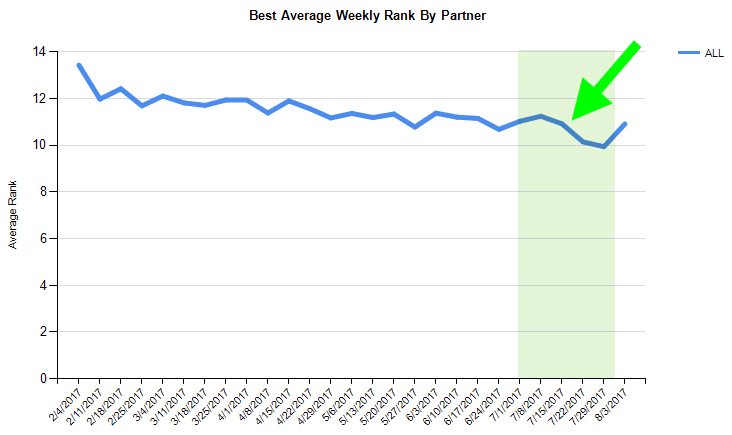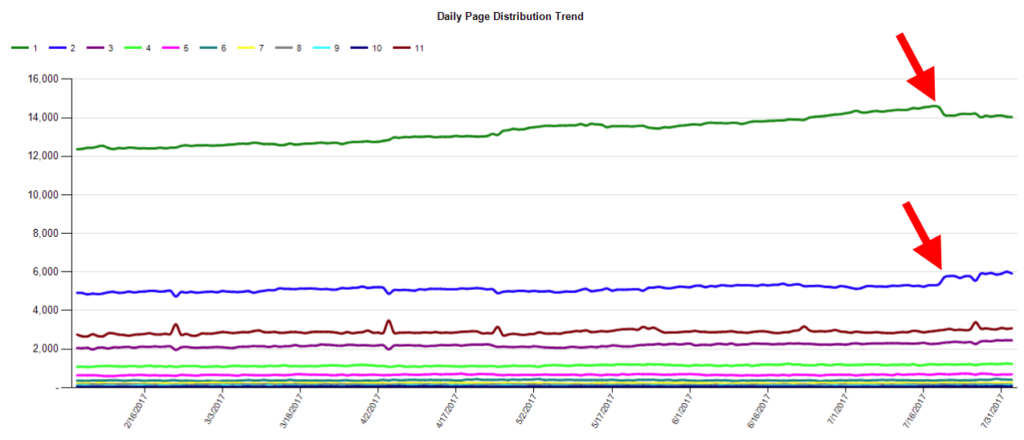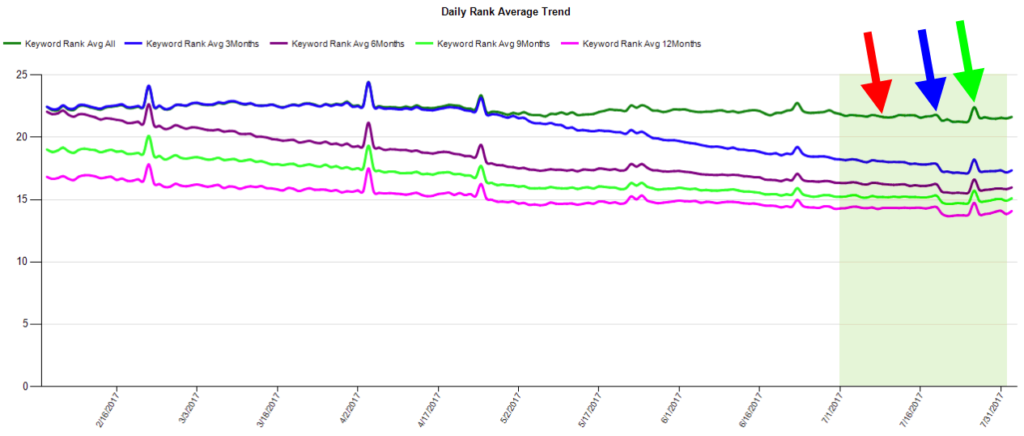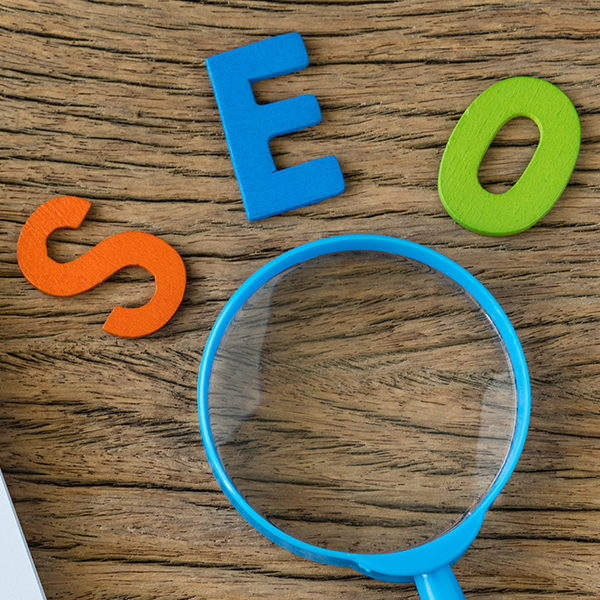In July we followed our typical trend of mostly positive movement. We saw consistent downward movement in our average ranking (which is what we want to see, because it shows the rank is getting closer to #1). We did see a few spikes which are believed to be algorithm updates. One of them was very positive for us. We also had a product test finalize and some other advances on company initiatives – details are below.
Lastly, I have some reminders about SEO from general questions or conversations I have had recently.
General Ranking Trends
Our rankings trends for this month were pretty stagnant (as normal) until around July 19th when we saw an increase in our average rankings.

What is curious with this drop is that around that same time we saw a drop in first page rankings and an increase in page 2 rankings. The general movement we saw around this time was rank decreases from the lower ranks on the first page.

Speculation is that there was a shift in what Google understands the potential intent or understanding of the query was tweaked. It also is possible that there was an uptick of new featured snippets or result types (maps, ads carousels, etc.) that could have pushed ranks back. Unfortunately, there was much noise from others within the industry citing large movement.
Google Algorithm Updates
This month we did see a few updates outside of the one noted above. One was around the 8th of July (RED ARROW) which was believed to be further testing by Google. This was noted by quite a few webmasters in the industry and was officially flagged as an update.
What this means to small business owners
- This update was noted but nothing substantial has been revealed to say what the exact factors were at play. Considering we didn’t see much impact I would assume this was more of a national impacting update.
What you should do about it
- With our assumption that this update was more national small businesses don’t have much action to take here.
Secondly, as noted above we saw a jump around the 19th of July (BLUE ARROW). There was not much noted by the industry so it is possible this was an isolated update.
What this means to small business owners
- The current guess is that this was an update surrounding the understanding of local queries. It is possible there was a shift in result types as well that could be pushing organic results further back. Either way, we are not entirely sure of the cause for this update and without industry inputs or statements from Google, the exact cause is unknown. This could be a case of our proprietary data giving us insights that the industry doesn’t catch, or it could be just an isolated incident.
What you should do about it
- Make sure you match the intent of the keywords you are targeting. Asking a question like “what is the searcher trying to accomplish?” can help you determine any content you may be missing.
Lastly, there was a blip of an update on 7/27 which we believe was an update with a quick reversal.
What this means to small business owners
- This update was most likely a quick test with a quick reversal.
What you should do about it
- Not much is needed for this other than staying the course. It is helpful to keep in mind that Google makes hundreds of updates per year, where a good portion are just tests.
Outside of the update on the 8th of July not much has been said or noted by the industry.

Business SEO Goals
Here I wanted to take a quick minute and advise on something I have seen come up quite a bit recently. When we think of SEO we often think of rankings, traffic, and conversions. Something we often tend to forget is how long it can take to achieve such results. We also tend to forget that in order to see MORE success we have to create MORE content. Let me go a little bit in-depth to help expand some metaphors and analogies to potentially help you educate clients.
Organic SEO Takes Time – Especially without Current Rankings
 To start I just wanted to remind everyone it takes time to rank. This does not mean there is an issue with us or our work. It simply is a fact in SEO, to build something naturally takes time. Just like planting a seed and waiting for a plant to grow, you can fertilize, water, and give it direct sunlight. At the end of the day, it simply takes time for the plant to grow. All of those extra elements simply help ensure consistent growth.
To start I just wanted to remind everyone it takes time to rank. This does not mean there is an issue with us or our work. It simply is a fact in SEO, to build something naturally takes time. Just like planting a seed and waiting for a plant to grow, you can fertilize, water, and give it direct sunlight. At the end of the day, it simply takes time for the plant to grow. All of those extra elements simply help ensure consistent growth.
Site Expansion is Key – To Get MORE You Have to Offer MORE
 To be considered the best you have to offer the best. When it comes to ranking organically this often is in the form of content. When we typically start a campaign we pick a page, allocate keywords, and optimize the page. This onsite work with offsite work helps us achieve rankings. In today’s search landscape that is the bare minimum that we can do to get organic traffic. Becoming an authority and a resource is the trick to getting more visitors and growing a brand. This means creating a lot of content (Text, Videos, Images, Graphs, Charts, Guides, etc.). Always keep this need for expansion in mind when helping clients understand how they should grow their business organically.
To be considered the best you have to offer the best. When it comes to ranking organically this often is in the form of content. When we typically start a campaign we pick a page, allocate keywords, and optimize the page. This onsite work with offsite work helps us achieve rankings. In today’s search landscape that is the bare minimum that we can do to get organic traffic. Becoming an authority and a resource is the trick to getting more visitors and growing a brand. This means creating a lot of content (Text, Videos, Images, Graphs, Charts, Guides, etc.). Always keep this need for expansion in mind when helping clients understand how they should grow their business organically.
SEO is a Longterm Solution – Moving a Mountain Takes Time
 This is something even I tend to forget, and this little analogy always reminds me of what we should really strive for with SEO. Basically, as everyone knows it takes time to move mountains. You cannot do it overnight, or in months, but over the span of years. This is similar to SEO in that it takes time to build your online reputation and content. The reason most companies should strive to rank organically is the lasting nature of building great content and authority. Just like moving a mountain, once it is moved it will take time for it to erode away. The overall benefits come down to how big of a mountain you move/create.
This is something even I tend to forget, and this little analogy always reminds me of what we should really strive for with SEO. Basically, as everyone knows it takes time to move mountains. You cannot do it overnight, or in months, but over the span of years. This is similar to SEO in that it takes time to build your online reputation and content. The reason most companies should strive to rank organically is the lasting nature of building great content and authority. Just like moving a mountain, once it is moved it will take time for it to erode away. The overall benefits come down to how big of a mountain you move/create.
- Quick Tip – Wondering why a website isn’t ranking? Look at the top ranking results closest related to the website. This is the best way to spot needs in content, authority, or usability.
Key Articles
As always here are a bunch of read-worthy articles from the last month. While nothing hugely impacts our client base, it’s good to know or at least have a pulse on.
- iFrame Content Can be Indexed – A question was posed to Google’s John Mueller who confirmed that they do fetch and index content in iFrames. (Source)
- Bolding Content Could Help Rankings – John Mueller explained via twitter that while bolding content does not have a direct benefit, it does have a secondary benefit. If formatting your text helps your clients use your page better it can have a positive impact on rankings. (Source)
- Missing Search Console Data – Newer users to Google Webmaster tools will be missing some data in their dashboard. (Source)
- July 8th Algorithm Update – Just a few snippets and comments about what was seen on July 8th indicating a Google algorithm update. (Source)
- Mini GMB Dashboard – You can potentially see the ability to edit GMB information from a direct business search. (Source)
- Carousel Site Links – Google is testing some formats for showing multiple links. One of the newest ones carouseling (Source)
- Instant Search is No More – Google’s instant search feature has been removed from search engine to give better usage consistency between mobile and desktop. (Source)
- Commas in Titles are Fine – John Mueller confirmed that commas in titles are totally fine to use without any concern of crawl or understanding. (Source)









